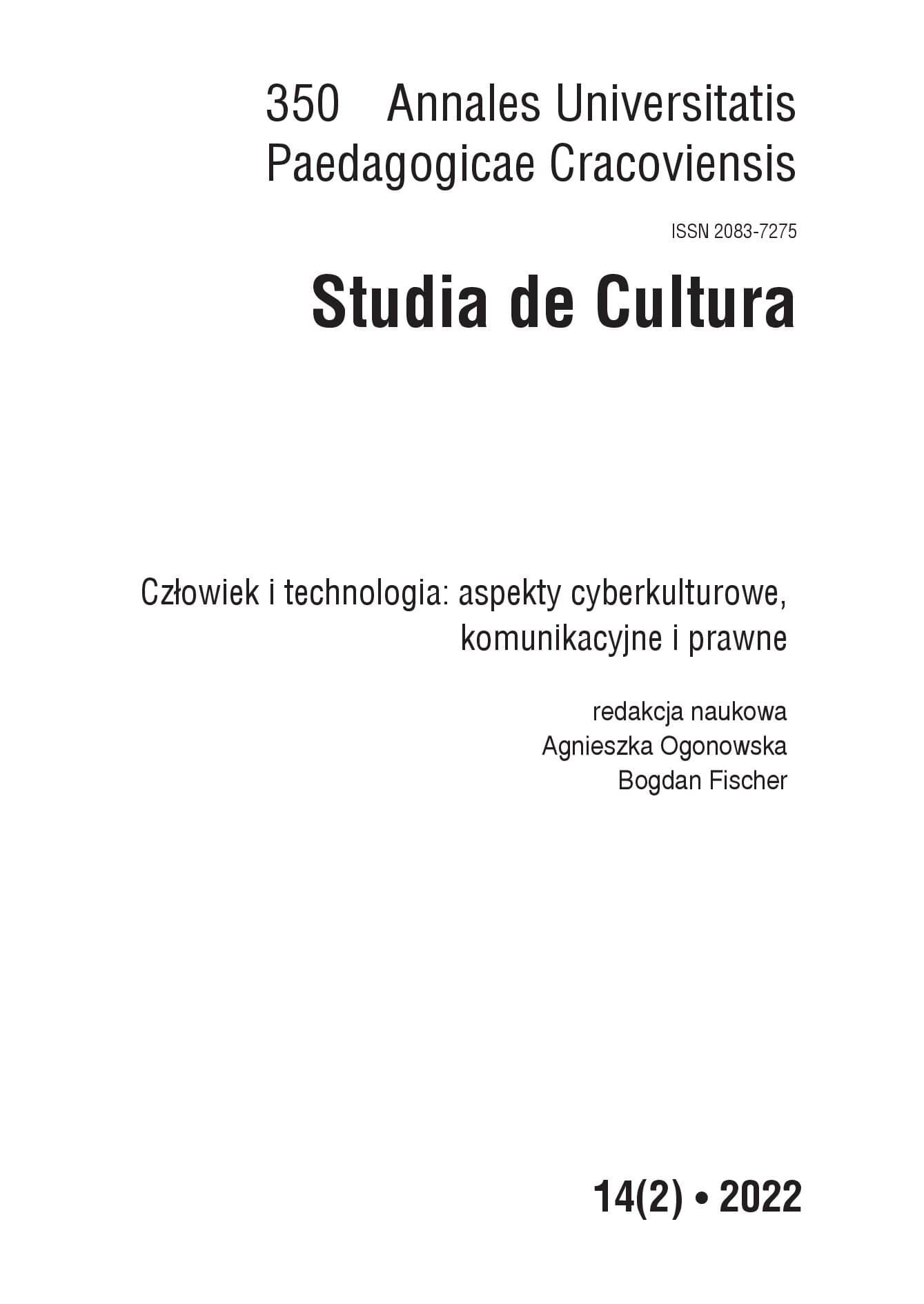Abstract
The aim of the article is to review and analyze the profiles of three influencers on the Instagram platform, who activated their communities in the virtual space to take real action during the COVID-19 pandemic in Poland. The focus was on the activities of the sex educator Katarzyna Koczułap, the podcasts of Joanna Okuniewska and the youtuber Katarzyna Gandor. The paper presents the results of a comparative analysis conducted with media content analysis, posts published in the first year of the pandemic COVID-19. The conclusions from the conducted research indicate the techniques used to strengthen the message of influencers in social media.
References
Argyris Young, Wang Zuhui, Kim Yongsuk, Yin Zhaozheng. 2020. „The Effects of Visual Congruence on Increasing Consumers’ Brand Engagement: An Empirical Investigation of Influencer Marketing on Instagram Using Deep-Learning Algorithms for Automatic Image Classification”. Computers in Human Behavior nr 112. 1–2. https://doi.org/10.1016/j.chb.2020.106443. (dostęp: 20.04.2021).
View in Google Scholar
Balog-Way Dominic H.P., McComas Katherine. 2020. „COVID-19. Reflections on Trust, Trade Offs, and Preparedness”. Journal of Risk Research nr 23. 7–8. https://doi.org/10.1080/13669877.2020.1758192. (dostęp: 25.05.2021).
View in Google Scholar
Boomgarden Hajo, Heidenreich Tobias, Jost Pablo, Eberl Jakob-Moritz, Tolochko Petro. 2020. „What’s in a Post? How Sentiment and Issue Salience Affect Users’ Emotional Reactions”. Journal of Information Technology and Politics nr 17(1). 48–54. https://doi.org/10.1080/19331681.2019.1710318. (dostęp: 16.07.2021).
View in Google Scholar
Brief. 2020. „Influencerzy w dobie pandemii. Czego od internetowych liderów opinii oczekują Polacy?”. https://brief.pl/influencerzy-w-dobie-pandemii-czego-od-internetowych-liderow-opinii-oczekuja-polacy/. (dostęp: 14.07.2021).
View in Google Scholar
Dryjańska Anna. 2020. Pod osłoną epidemii PiS przepycha barbarzyństwo. Oto co Kaczyński chce zrobić kobietom. https://natemat.pl/324121,o-co-chodzi-w-sprawie-tk-i-aborcji-powiedz-komus-czarny-protest-kobiet. (dostęp: 12.07.2021).
View in Google Scholar
Ge-Stadnyk Jing, Gretzel Ulrike. 2018. „Emoji Rhetoric. A Social Media Influencer Perspective”. Journal of Marketing Management nr 34. 15–16. https://doi.org/10.1080/0267257X.2018.1483960. (dostęp: 28.05.2021).
View in Google Scholar
Gilger Megan, Gilger Mike. 2016. 11 Things You Should Know about Influencer Marketing. http://cdn2.hubspot.net/hub/256900/file-66482825-pdf/11_Things_InfluencerMarketing.pdf. (dostęp: 15.07.2021).
View in Google Scholar
Gliwa Sylwia. 2019. Wpływ mediów społecznościowych na opinie i nastroje społeczne. W: Edukacja dla bezpieczeństwa. Maria Kozielska (red.). Poznań. 248.
View in Google Scholar
Househ Mowafa. 2016. „Communicating Ebola through Social Media and Electronic News Media Outlets: A Cross-Sectional Study”. Health Informatics Journal nr 22(3). 470–478. https://doi.org/10.1177/1460458214568037. (dostęp: 12.07.2021).
View in Google Scholar
Ismail Kaya. 2018. „Social Media Influencers: Mega, Macro, Micro or Nano”. https://www.cmswire.com/digital-marketing/social-media-influencers-mega-macro-micro-or-nano/. (dostęp: 14.07.2021).
View in Google Scholar
Jaska Ewa, Werenowska Agnieszka, Gomoła Bartosz. 2019. „Wykorzystanie influencer marketingu w kreowaniu wizerunku marki”. Polityki Europejskie, Finanse i Marketing nr 21(70). 79–84.
View in Google Scholar
Kelman Herbert. 1961. „Process of Opinion Change”. Public Opinion Quarterly nr 25(1). 57–78. https://doi.org/10.1086/266996. (dostęp: 12.07.2021).
View in Google Scholar
Kuczamer-Kłopotowska Sylwia, Piekarska Kinga. (2018). „Realizacja funkcji influencer marketingu w opinii influencerów oraz ich followersów”. Journal of Management and Finance nr 16(3). 162–163.
View in Google Scholar
Lou Chen, Yuan Shupei. 2019. „Influencer Marketing: How Message Value and Credibility Affect Consumer Trust of Branded Content on Social Media”. Journal of Interactive Advertising nr 19(1). 58–73. https://doi.org/10.1080/15252019.2018.1533501. (dostęp: 16.07.2021).
View in Google Scholar
LoveBrands Relations. 2020. „Influencerzy w dobie pandemii. Czego od internetowych liderów opinii oczekują Polacy?”. https://lbrelations.pl/pl/news/489,influencerzy-w-dobie-pandemii-czego-od-internetowych-liderow-opinii-oczekuja-polacy. (dostęp: 15.07.2021).
View in Google Scholar
„Najlepsze działania influencerów w trakcie pandemii w 2020 roku”. https://socialpress.pl/2021/01/najlepsze-dzialania-influencerow-w-trakcie-pandemii-w-2020-roku. (dostęp: 14.07.2021).
View in Google Scholar
Nowak Marta. 2020. „Kasia mówi, co z tym seksem: Uczę, zamiast mówić o grzechu. Długo odchodziłam z Kościoła”. https://oko.press/co-z-tym-seksem/. (dostęp: 16.07.2021).
View in Google Scholar
Oficjalny profil Joanny Okuniewskiej na Instagramie. https://www.instagram.com/tu_okuniewska/. (dostęp: 27.04.2021).
View in Google Scholar
Oficjalny profil Katarzyny Gandor na Instagramie. https://www.instagram.com/kasiagandor/. (dostęp: 27.04.2021).
View in Google Scholar
Oficjalny profil Katarzyny Koczułap na Instagramie. https://www.instagram.com/kasia_coztymseksem/. (dostęp: 27.04.2021).
View in Google Scholar
Ostrówka Agata. 2014. Idiostylowy charakter parentez w tekstach Antoniego Libery. Kwartalnik Językoznawczy nr 17(1). 26.
View in Google Scholar
Ouvrein Gaëlle, Pabian Sara, Hudders Liselot, Backer De Charlotte. 2019. „The Web of Influencers. A Marketing-Audience Classification of (Potential) Social Media Influencers”. Journal of Marketing Management. 1–30.
View in Google Scholar
Raport #Hashoff Influencer marketingu. https://www.hashoff.com/. (dostęp: 15.07.2021).
View in Google Scholar
Subramani R. Mani, Rajagopalan Balaji. 2003. „Knowledge-Sharing and Influence in Online Social Networks via Viral Marketing”. Communications of the ACM nr 46(12). 300–307. https://doi.org/10.1145/953460.953514. (dostęp: 19.07.2021).
View in Google Scholar
Veirman De Marijke, Hudder Liselot. 2019. „Disclosing Sponsored Instagram Posts: The Role of Material Connection with the Brand and Message-Sidedness When Disclosing Covert Advertising”. International Journal of Advertising nr 39(1). 99. https://doi.org/10.1080/02650487.2019.1575108. (dostęp: 19.07.2021).
View in Google Scholar
Ziegele Marc, Weber Mathias, Quiring Oliver. 2018. „The Dynamics of Online News Discussions: Effects of News Articles and Reader Comments on Users’ Involvement, Willingness to Participate, and the Civility of Their Contributions”. Information, Communication and Society t. 21, nr 10. 1–15. https://doi.org/10.1080/1369118X.2017.1324505. (dostęp: 25.05.2021).
View in Google Scholar

This work is licensed under a Creative Commons Attribution-NonCommercial 4.0 International License.

